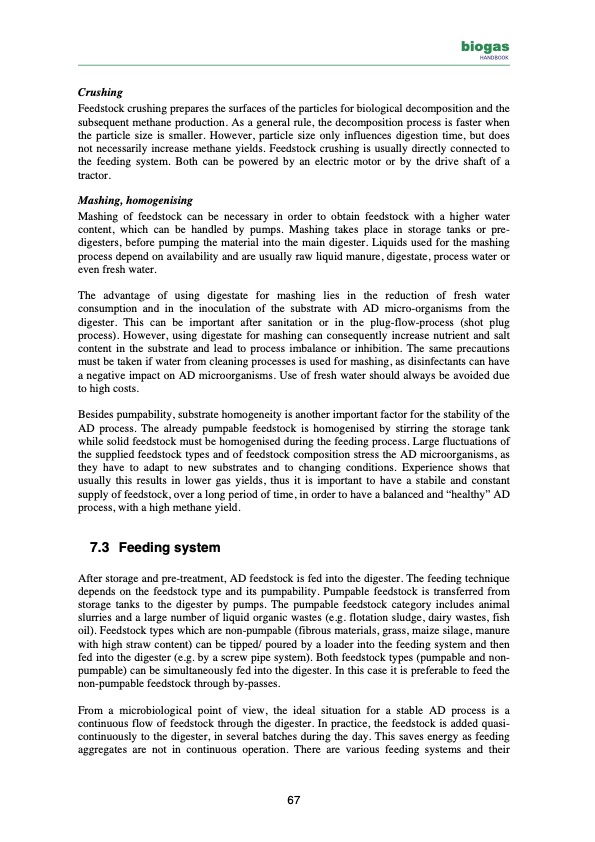
PDF Publication Title:
Text from PDF Page: 067
Crushing Feedstock crushing prepares the surfaces of the particles for biological decomposition and the subsequent methane production. As a general rule, the decomposition process is faster when the particle size is smaller. However, particle size only influences digestion time, but does not necessarily increase methane yields. Feedstock crushing is usually directly connected to the feeding system. Both can be powered by an electric motor or by the drive shaft of a tractor. Mashing, homogenising Mashing of feedstock can be necessary in order to obtain feedstock with a higher water content, which can be handled by pumps. Mashing takes place in storage tanks or pre- digesters, before pumping the material into the main digester. Liquids used for the mashing process depend on availability and are usually raw liquid manure, digestate, process water or even fresh water. The advantage of using digestate for mashing lies in the reduction of fresh water consumption and in the inoculation of the substrate with AD micro-organisms from the digester. This can be important after sanitation or in the plug-flow-process (shot plug process). However, using digestate for mashing can consequently increase nutrient and salt content in the substrate and lead to process imbalance or inhibition. The same precautions must be taken if water from cleaning processes is used for mashing, as disinfectants can have a negative impact on AD microorganisms. Use of fresh water should always be avoided due to high costs. Besides pumpability, substrate homogeneity is another important factor for the stability of the AD process. The already pumpable feedstock is homogenised by stirring the storage tank while solid feedstock must be homogenised during the feeding process. Large fluctuations of the supplied feedstock types and of feedstock composition stress the AD microorganisms, as they have to adapt to new substrates and to changing conditions. Experience shows that usually this results in lower gas yields, thus it is important to have a stabile and constant supply of feedstock, over a long period of time, in order to have a balanced and “healthy” AD process, with a high methane yield. 7.3 Feedingsystem After storage and pre-treatment, AD feedstock is fed into the digester. The feeding technique depends on the feedstock type and its pumpability. Pumpable feedstock is transferred from storage tanks to the digester by pumps. The pumpable feedstock category includes animal slurries and a large number of liquid organic wastes (e.g. flotation sludge, dairy wastes, fish oil). Feedstock types which are non-pumpable (fibrous materials, grass, maize silage, manure with high straw content) can be tipped/ poured by a loader into the feeding system and then fed into the digester (e.g. by a screw pipe system). Both feedstock types (pumpable and non- pumpable) can be simultaneously fed into the digester. In this case it is preferable to feed the non-pumpable feedstock through by-passes. From a microbiological point of view, the ideal situation for a stable AD process is a continuous flow of feedstock through the digester. In practice, the feedstock is added quasi- continuously to the digester, in several batches during the day. This saves energy as feeding aggregates are not in continuous operation. There are various feeding systems and their 67 biogas HANDBOOKPDF Image | biogas HANDBOOK

PDF Search Title:
biogas HANDBOOKOriginal File Name Searched:
BiogasHandbook.pdfDIY PDF Search: Google It | Yahoo | Bing
Capstone Turbine and Microturbine: Capstone microturbines used and new surplus for sale listing More Info
Consulting and Strategy Services: Need help with Capstone Turbine, sizing systems, applications, or renewable energy strategy, we are here to assist More Info
Container Lumber Dry Kiln: Since 1991 developing and innovating dry kilns using standard shipping containers More Info
Supercritical CO2 Lumber Dry Kiln: Compact fast drying in 3 days or less for small amounts of wood and lumber drying More Info
BitCoin Mining: Bitcoin Mining and Cryptocurrency... More Info
Publications: Capstone Turbine publications for microturbine and distributed energy More Info
FileMaker Software for Renewable Energy Developing database software for the renewable energy industry More Info
CO2 Gas to Liquids On-Demand Production Cart Developing a supercritical CO2 to alcohol on-demand production system (via Nafion reverse fuel cell) More Info
Stranded Gas for low cost power Bitcoin Mining Using stranded gas for generators may provide breakthrough low power costs for cryptocurrency miners. More Info
| CONTACT TEL: 608-238-6001 Email: greg@globalmicroturbine.com | RSS | AMP |